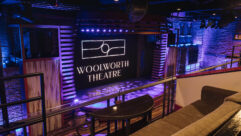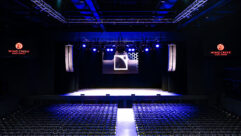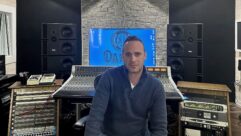PAST AND PRESENT
Apr 1, 2000 12:00 PM,
Wolfgang Ahnert, Jim Brown and Helmut R. Grothe
Integrating a high-quality, expandable digital audio system at the DeutscheOper Berlin.
In its original form, the Deutsche Oper was inaugurated in November 1912 inthe historic Charlottenburg section as Deutsches Opernhaus (German OperaHouse). The facility was rebuilt after World War II, and the mainperformance space reopened on September 24, 1961. The new building wasdesigned by the architect Professor Fritz Bornemann in the style of thelate 1950s, and it included parts of the original structure that hadsurvived the war.
The main performance space seats 1,885 spectators with balconies and sideboxes at two levels. The reverberation time of about 1.5 seconds wasoptimized by Professor Cremer in 1961 for operatic performance and wasachieved without the use of electronic enhancement simply because it wasnot available at the time.
Work on installation of new systems began in 1989 and is still currentlyunderway. One of the greatest challenges has been the sheer size of thefacility and its performance spaces; Deutsche Oper Berlin occupiesapproximately 172,000 ft superscript 2 (16,000 m superscript 2) and has abuilding volume of more than 10,600,000 ft superscript 3 (300,000 msuperscript 3), including the main audience chamber, stage house, rehearsalstages, orchestra room, workshops, storage and administration.
Sound reinforcement solutions
The first part of the new sound system was installed in 1989. In thelateral portals (the cheek walls flanking the forestage) a 4 2 array ofhigh-performance compact loudspeaker systems (d&b Audio F1220) wasinstalled, appropriately inclined and swiveled one on top of the other toprovide the required coverage (Main Group 2 in Figure 1). Over theproscenium, an additional 2 2 array of the same loudspeaker systems wasarranged side by side (Main Group 1 in Figure 4). The job was not toradiate much sound to the side walls but to supply a full sound to theaudience. The d&b Audio F1220 is a two-way system that is well regarded inGermany in theatre applications, and it works quite well at Deutsche OperBerlin. To help supply a stereo image, the existing finish covering theside walls of the forestage has been replaced by a new, acousticallytransparent net grid composed of thick wire spaced by about 1 inch (25.4mm). Behind this visually opaque grid can be hidden some sound reflectorsto supply short time reflections back to the musicians within the orchestrapit. Figure 2 shows the direct sound level mapped over the audience areas.Although the calculation includes interference and shadowing, it shows agood and smooth direct sound coverage. Because listeners in areas A14 andA15 are sitting in separate boxes that are partially shadowed from theproscenium clusters, these boxes must be covered with separate smallceiling loudspeakers.
One compromise made during this initial upgrade was to allow direct soundlevels in the upper balcony (audience areas A13 and A13*) to fall off a bitdue to the inverse square law. During the next stage of work, additionalloudspeakers (Main Group 3) will be installed to provide a bit more directsound to this area, thereby supplementing the inverse square loss of theproscenium loudspeakers. It will not be necessary to re-aim some of theexisting loudspeakers when the new loudspeakers are installed.
To cover the first rows of the audience, connection sockets for additionalloudspeakers were installed in the vertical face of the stage. These mayalso be used for connecting portable loudspeaker systems, such as foldback(stage monitor), a speaker’s desk and precedence loudspeakers built into apodium.
The main reinforcement system can provide 10 W to 15 W, which correspondsto a maximum SPL of 105 to 107 dB in the diffuse field of the auditorium(with L subscript r = L subscript W – 10 log V/ft superscript 3 dB + 10logRT/s + 29.35 dB). A key design criteria was good intelligibility for speechand good clarity for music. Figure 3 shows the expected values for ALsubscript cons that have been confirmed by measurements of the installedsystem at key locations.
In 1991 new systems for performer foldback (stage monitoring) and soundeffects precedence were installed in the stage area (Main Groups 4, 6 and8). Main Groups 5 and 7 are to be installed during the next developmentphase. The d&b model F1220 will be used for Groups 6 and 8, d&b model B1(sub-woofer, 32 Hz to110 Hz) and d&b model F2 (137 dB maximum level, 60 40,2 inch horn and 20 12 0 or 51 mm 305 mm cone loudspeaker) for Main Group 4.
Signal distribution, routing and mixing
Next in the order of priorities was an extensive system for routing anddistribution of mic and line level audio signals around the performance andrehearsal spaces. From the beginning, it was decided that a fully digitalsystem would provide the greatest flexibility and highest level ofperformance.
The design team at Acoustic Design Ahnert (ADA), consultants for theproject, decided to try to integrate the mixing system with the signaldistribution system. They used a mixing console that could operate fully inthe digital domain, take its inputs as digital signals from the routingsystem, perform all signal processing in the digital domain and return itsoutputs to the routing system still in the digital domain. The systemschosen for the project were the Nexus routing and distribution system andCantus mix consoles, both products of the German manufacturer, Stage Tec.The mixing consoles contain no analog or digital audio electronics; theyare control surfaces for the centrally located DSP and routing electronics.Two mix consoles were designed into the system. One usually resides in thecontrol room for the main performance space where it is primarily used tomix for sound reinforcement, surround sound, the hearing-impaired system,and performer foldback (stage monitors). The other resides in the rehearsalhall’s control room and is used to record rehearsals and performances inboth spaces and to play back music and effects for rehearsals. The twoconsoles are identical and interchangeable via the routing system, and arethus able to act as spares for each other.
The physical configuration of the routing system is built around what StageTec calls a “Base Device,” a 3 RU, 19 inch (483 mm) frame that contains 20free slots to house the different input and output boards at each location.Available formats are analog in (mic and line), analog out, AES, SPDIF,SDIF-2, Y2, MADI, ADAT, TDIF and digital mic (AES with phantom power).Furthermore, a signal processor board and different transmission boards fordata and GPI/GPO are available. All these different formats are convertedinto a common format that is similar to the AES format but contains someinformation to synchronize the system and to carry remote control data.These signals are routed throughout the entire network. So the completesystem is always synchronous and requires no additional format convertersto work with the different signals that may occur in the facility.
The Cantus consoles are essentially control surfaces that allow users tomanipulate mixing and signal processing functions that are implemented inDSP. They combine the best of both worlds, using displays, indicators,switches, and controls that are all assignable to nearly any imaginablefunction, depending on the needs of any given production. Virtually everyelement of the console is freely assignable – the audio channels as well asthe user surface. All knobs work in combination with displays that show theselected parameter and its value in analog and digital form.
The audio signal processing of the mixing consoles (for input channels,groups, sums and AUX sums) is designed for 90 audio channels plusmonitoring. Every input and output of the entire Nexus network can beconnected to both of the consoles. Thus, the operator can mix anycombination of mics and line level or digital sources to any combination ofoutput busses and then assign those busses to any channel of the soundreinforcement, effects playback and stage monitor systems.
The console has its own fiber optic connection to the central processingunit, but for the most part, this connection carries only control signals.The only audio signals at the desk are those used to drive headphones andcontrol-room monitor loudspeakers, which sit atop the overbridge.
Overall configuration of the routing and distribution system is a networkedfunction, and it can be achieved from any of the control locations. At eachof the base devices (I/O racks), a control PC can be connected via serialinterface (RS-232 and RS-422). A special protocol is used. Basic adjustmentand configuration at the consoles are done via an integrated graphicstablet or keyboard and graphically shown on the TFT monitor installed inthe meter bridge plane. All audio settings have to be effected through thecontrollers and switches of the operating channels faders by means of thekeyboard.
Stage management and utility systems
To facilitate operation of these systems, it was decided to integrate theuser interface for all of them (intercom, call lights, voice paging,program monitoring and video) into principal user stations at selectedlocations. Primary control locations chosen were downstage right, downstageleft, the control rooms, the in-house mix location, and the centralequipment rack (in the basement). The greatest operational control would berequired at the two stage management positions, downstage left and right.At other primary locations, multi-key, table-mounted master stations wouldbe required. The remaining locations would need simpler portable stations,such as a belt pack or compact loudspeaker station. All stations required abuilt-in mic, loudspeaker, a headset jack and two-color light-signalingdevices. The great number of rooms to be covered by these systems and thecomplexity of the control functions required for each dictated the use of acomputer-based control system for the combined systems.
Intercom stations (18 permanent and more portable ones) would be neededthroughout the performance spaces and in work areas, and nearly 400loudspeakers would be required throughout the building. All centralelectronics for the system would be housed in the main equipment room inthe basement. The intercom system should provide configurations for morethan 20 simultaneous party-line conversations with any user stationassignable to any group. The stage manager and the director also needed awireless user station so that he could act from different places on stage,for commands to groups or rooms that are routed first on the stage managerconsole and to listen to his intercom-circuit.
Salzbrenner, Hallstadt, Germany, was chosen as the contractor for the stagemanagement system. Hardware for the intercom system was designed andmanufactured by Salzbrenner and StageTec. The stage manager consoles, allintercom stations, and light signaling components are custom products bySalzbrenner. Audio routing uses a StageTec Nexus frame with A/D and D/Aconverters. The video routing system uses four units of the Ernitec System1000M.
The intercom signal is transmitted digitally over standard four-pair CAT5UTP cable to each user station. The cable also carries DC power for all butthe largest user stations. Each user station (master station, loudspeakerstation, beltpack or portable signal light) is addressable. The four-pairbuss cabling (CAT5 UTP type), wired party-line style (circulating to allstations as opposed to a dedicated home run to each station) carries thecontrol signals, monitoring of the 100 V distributed paging system andpaging access to the 100 V distributed for stage manager call (for example,back of house paging).
An all-call voice-paging system provides for the transmission ofpreprogrammed announcements from the intercom system’s digital speechmemory and live announcements from any of the primary intercom stations. Incase of emergency or evacuation, it is possible to activate the pagingsystem with overriding priority. Via the independent power supply of thecentral unit, the system also remains operable in case of main powerfailure for emergency announcements for the required period of 30 minutes.There is no backup power for the reinforcement system.
Voice paging and performance sound from the auditorium and the stage istransmitted to various rooms throughout the building on a multizone 100 Vdistributed system. Most rooms have performance sound with voice pagingoverride, but some areas (floors and open areas) have paging only.Performance sound can be individually controlled in each room, but pagingcannot.
To provide program sound, a total of 11 mics are installed at variouslocations around the stage and audience chamber. Because the stage is solarge, more than one stereo pair is often used; the sound operator buildsthe required mix of these mics for any given production. A mono sum is usedto feed the distributed 100 V system, the hearing-impaired system, and thestage management (intercom) systems.
At locations where more critical listening is required, the room monitormics are fed as a +6 dBu line level signal (the nominal level of Europeanbroadcasters) and reproduced on active monitor loudspeakers. In addition tothe control rooms, the line level signal is used at director positions, andcan be sent elsewhere as needed by the audio router.
The new video system includes all new wiring and routing infrastructure,and remotely controlled cameras have been installed in the auditorium andstage areas. Three closed-circuit channel modulators can be dedicated todistribution of these cameras, allowing up to three different cameras (orany other video program) to be viewed simultaenously via the in-housebroadcast cable system. Images can also be routed to networked PCs via thehouse’s Ethernet connection. The video transmission system includes acharacter generator, which is used to display a programmed sequence ofnumbers to indicate the progress of the production (called “integrated actindication”). The stage manager can select any number (an act or scenenumber, for example), which is then inserted into the desired video feeds.
A total of six cameras are currently in use and can be switched to feed anyof the three RF video modulators.
In addition to the RF distribution system, certain users (technicaldirector, stage managers, sound operators, light controllers or directors)can view any of the video sources via their own dedicated basebandcomposite video feeds directly from the video crosspoint switcher. Thesystem is capable of handling RGB, RGBHV and digital video, but with theexception of feeds to the computer network, only composite video iscurrently supported at input and output locations. The routing electronicsfor this system are installed in the basement rack room.
In the wings downstage right and left, there are two identical stagemanager consoles. The consoles may be used individually, in combination orin a redundant mode for coordinating the performance flow. From each, thestage manager can view and control any of six (one is in standby) videocameras, listen and talk to all configured matrix points, control more than40 light signs, control the back of house paging system, and makeannouncements to both front of house and back of house areas.
This new computer network enables a universal exchange of sound programswithin the opera house, which it is hoped will be expanded to include otherhouses of the city of Berlin.










